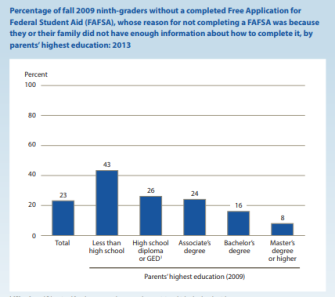
One quarter of high school students don’t fill out the federal form they need to get financial aid, according to a new study. And the biggest reason they don’t is that many think their families can afford college without that support.
The new , follows students who were freshmen in the fall of 2009. Sixty-five percent of those students completed the Free Application for Federal Student Aid, or FAFSA. Twenty-four percent didn’t. The remaining 11 percent didn’t know what a FAFSA was or if they finished it.
Here are the reasons students cited for not filling out the FAFSA:
- Didn’t think they needed the aid to afford college (33 percent)
- Thought they might not qualify for financial aid (32 percent)
- Didn’t want to take on debt (28 percent)
- Didn’t have enough information about how to complete a FAFSA (23 percent)
- Didn’t plan to continue their education after high school (22 percent)
- Didn’t know they could complete a FAFSA (15 percent)
- Thought FAFSA forms take too much time or work (9 percent)
Delving into why students don’t fill out the FAFSA could fuel solutions to one of the big barriers to college: obtaining the loans or grants that make it affordable. Every year, students leave millions of available aid dollars untouched.
Federal officials have been working on this problem for years. They’ve shortened and simplified the FAFSA process and recently debuted a .
The new federal report showed that race and parents’ education levels shaped patterns of FAFSA completion. Black and Hispanic students, and students whose parents had a high school education or less, were far more likely to say they didn’t have enough information about how to do the FAFSA.


The National College Access Network has tracked FAFSA patterns for years. The new data echoed some of what it’s seen in its own research. 69��ý often don’t understand what makes them eligible for financial aid, and often think they’re ineligible when they’re not, said NCAN’s policy director, Carrie Warick.
“They are self-selecting out before they even get to a point where they’d discover how long the form is,” she said in an email.
Warick said she thinks NCES’ 65 percent completion rate could be a bit high because it’s based on survey data. When they’re asked if they completed a FAFSA, some students might say they did, but be unaware that they’d skipped a step, Warick said.
, and they’re more sobering than the ones in the new federal report. Of 2018 high school graduates, 61 percent submitted a FAFSA. In 2015, that rate was 57 percent. The NCES study focused on the class of 2013.
Photo: Getty Images
